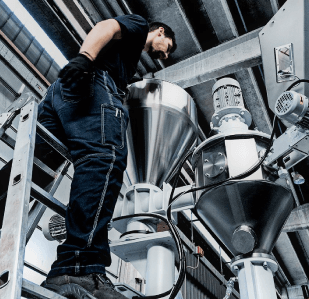What are WPCs and WPC composite products?
WPCs are composite materials containing a wood component in particle form and a polymer matrix. This product class has been developing over the last fifty years, resulting in increased applications and extended market share.
The matrix could be a thermoplastic polymer such as PVC, PE or PP, which can be processed at relatively low temperatures that prevent wood thermal degradation. Furthermore, these composite materials are attractive because they can be worked with tools already used for wood construction.
Wood as a filler has many advantages to other traditional fillers: lower cost, high strength-to-weight ratio, low density and, last but not least, it’s a renewable resource. In fact, the wood material used in WPCs often comes from post-industrial co-products.
Now, let’s delve into WPC properties and physical characteristics
Composite materials are often optimized by selecting components for their strength, stiffness, flexibility and durability. When compared to individual material, composites may offer more consistent performance, lower production costs and eco-friendliness. WPCs are no different, as mechanical and durability properties are the most important; WPCs in decking, fencing and railing applications make up the largest share of the WPCs market.
Due to its common uses, described above, we must consider at least two properties: the Ultimate Tensile Strength (UTS) and the Modulus of Elasticity (MOE).
The first represents the maximum stress that a material can be subjected to before breaking; the second refers to the ability to resist deformations. These two characteristics may vary according to the filler loading ratio in the composite. Higher loading ratio – up to 60% – increases the strength of the final object. Generally, this is the best ratio possible, as more filler quantity would not be encapsulated by the polymer, increasing the likelihood of problems. Another crucial aspect one should consider is the size of the wood particles, which affects the mechanical properties mentioned. The aspect ratio – length divided by the width of the largest minor axis – of the particles affects the properties of the final product. Larger aspect ratios – like wood fiber – lead to better mechanical properties, but difficulties can occur when feeding and metering the fibers into the extruder.
When compared to wood, WPC durability is less susceptible to moisture absorption and has better resistance to fungal attack. Moreover, it’s not subjected to dimensional changes thanks to the encapsulation of the wood particles by the polymer, which provides a good level of protection from biological decay. Thanks to its intrinsic properties, it does not age to the action of UV rays and it does not require maintenance.
WPC composite products – a sustainable solution
Nowadays, with the increased focus on recycling and reuse for the environmental impact of products, WPC composite products are one of the smartest choices in terms of sustainability. Wood-plastic composites feature the benefit of reduced melting temperature, resulting in lower energy costs for producers and further reducing the product’s environmental impact. And since wood does not need to be treated when making wood-plastic composites, wood scrap could be used immediately after being reclaimed, without the addition of potentially harmful chemicals. In addition, recycled plastics can also be used, significantly reducing the environmental impact. Moreover, WPCs are completely recyclable and, once used, can be converted into new granules and products.
For these reasons, WPCs fit well in a cradle-to-cradle scenario and represent a sustainable solution.
Case studies
Recently, a large toy manufacturer investigated prospects for improving their margins on a popular classic toy. They selected a wood-plastic composite alternative. The company began injection molding a wood-plastic composite instead of shaping wooden pieces, bypassing one of the most expensive steps in their manufacturing process.
An international pet products company turned to a wood-plastic composite to create a pet toy that combined the pleasing smell of wood with the safety and durability of plastic. Dogs loved the smell of wood and their owners appreciated a safer toy that would not splinter.
Growth prospects for WPC composite products
WPCs are the eco-friendly answer to building and architecture needs. They combine the aesthetics of natural wood with the sturdiness of plastics resins. They can adapt to any style, from classic to modern. By experimenting with the type and ratio of plastics blended with wood, different visual and tactile effects can be achieved. Different formulations are capable of yielding a variety of colors, more fibrous or smoother textures, more flexibility or more rigidity, as desired.
The market is already rewarding this composite material. In the European region, the WPC market is projected to a CAGR over 8% during the next 5 years. This growth is being driven by the increasing demand for WPC composite products in domestic construction and many opportunities are arising for those wishing to invest in this sector.





.jpeg)
.jpeg)